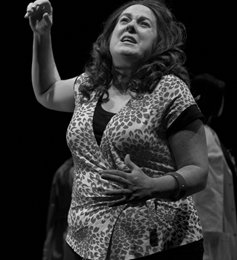The audience is met by a row of stiff and faceless mannequins with their backs to us, each draped in disparate costumes and each topped with a wig of varying colour and style. While one of these on their own would be a banal sight to behold, the odd phalanx they form at the back of the playing space offers an eerie greeting, and adds an unnameable menace to a story which could potentially be chalked up as another soap opera rehash. It’s from these figures that performer Clare Barrett dons the duds and hairdos of the broad array of characters that populate the world of the play.
Barrett first introduces us to Rhonda, the vengeful redhead of the play’s title, whose seeming innocence is belied by the sudden reveal of a bloodied handkerchief stuffed in her coat pocket. Rhonda tells us of her husband Graham’s decision to leave her and her suspicions, fuelled by Rhonda’s neighbour Lynette, that Graham has been fooling around with a nameless blonde from the local shopping centre. After Lynette eggs her friend on, Rhonda impulsively confronts a blonde in the shopping centre, brutally attacking the woman and accidentally killing her. The consequences of this act are explored through the reactions of those directly involved as well as those who only feel the murder’s residual effects.
 Writer Robert Hewett offers a compelling and surprising structure to the play, which fractures and extends from the perspectives of different times, places and consciousnesses as the wide-reaching impact of Rhonda’s attack is revealed. We meet the victim’s female partner Alex, who struggles to keep her family together in the wake of the murder; Alex’s neighbour, who watches as the victim’s children grow up bearing the weight of the senseless loss of their mother; and the victim’s four-and-a-half year-old son, who struggles to understand the significance of his mother’s absence. Hewett’s drawing of his characters is not always successful, and indeed some come off as slight and two-dimensional. For example, Rhonda’s husband Graham comes across as a boneheaded caricature rather than a fully formed character. Nonetheless, when Hewett does craft a sensitive portrait, the result, combined with Barrett’s detailed portrayal, can be very affecting. Rhonda’s growing bewilderment at her predicament, and Alex’s attempts to keep herself together as she looks over the body of her dying partner, prove to be especially moving.
Writer Robert Hewett offers a compelling and surprising structure to the play, which fractures and extends from the perspectives of different times, places and consciousnesses as the wide-reaching impact of Rhonda’s attack is revealed. We meet the victim’s female partner Alex, who struggles to keep her family together in the wake of the murder; Alex’s neighbour, who watches as the victim’s children grow up bearing the weight of the senseless loss of their mother; and the victim’s four-and-a-half year-old son, who struggles to understand the significance of his mother’s absence. Hewett’s drawing of his characters is not always successful, and indeed some come off as slight and two-dimensional. For example, Rhonda’s husband Graham comes across as a boneheaded caricature rather than a fully formed character. Nonetheless, when Hewett does craft a sensitive portrait, the result, combined with Barrett’s detailed portrayal, can be very affecting. Rhonda’s growing bewilderment at her predicament, and Alex’s attempts to keep herself together as she looks over the body of her dying partner, prove to be especially moving.
The play also veers away from any of the clichéd luridness of soap material thanks to Barrett’s generous performance. Under Breege Brennan’s direction, Barrett convincingly transitions from character to character, donning only a wig and costume piece to suggest the roles she plays. Changes in character physicality are subtle, and Barrett avoids pure caricature by exhibiting a disarming pathos that conveys an emotional depth Hewett’s writing sometimes can lack.
Scene transitions do at times seemed rushed, as if the production expected the audience to grow unduly impatient as Barrett changed wigs and costume pieces. With Ivan Birthistle’s satisfactory sound design covering transitions, Barrett ducks behind a mannequin to complete her costume change, as if attempting to hide from the audience’s sight-line as she assumes a new character. The intimate nature of the space doesn’t allow for complete disappearance, and Barrett is left exposed. It might perhaps have been more effective if the audience was made complicit in these transitions, with Barrett’s transformation consciously conducted in full view, offering an acknowledgment on the production’s part that Barrett is presenting these roles rather than somehow naturalistically inhabiting them.
Despite this, the sparseness and simplicity of Maree Kearns’ design cleverly provides tantalizing hints of how the play might unfold. Each costume piece and wig suggests a new character or unexpected plot twist that ultimately upends our understanding of the world of the play. While not every twist is successful, as when the nature of Graham’s relationship to the blonde is revealed, the presence of every characters’ costume or wig on stage beautifully marks the kind of fractal-like unravelling of the characters’ unexpected relationships to each other.
While employing some of soap opera’s hallmarks like suburban infidelity, petty revenge and melodramatic revelation, The Blonde, the Brunette and the Vengeful Redhead still achieves a level of emotional depth and complexity as a result of Barrett’s compelling performance. The result is a play that defies its own source genre and extends itself far beyond the company’s curious marketing pitch that it’s “CSI Miami meets Desperate Housewives.”
Jesse Weaver has recently been awarded a PhD in Theatre Studies from UCC, and is a playwright.